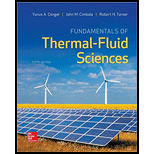
Concept explainers
The net work done and the net heat transfer by piston cylinder device.
Explanation of Solution
Given:
The initial pressure of steam
The initial temperature of steam
The initial volume of steam
The pressure at expansion
Calculation:
Refer Table A-6, “Superheated water” to obtain the value of internal energy state 1
Show temperature and internal energy values from the Table A-6 as below.
| Temperature | Internal energy |
| 300 | 2805.1 |
| 350 | ? |
| 400 | 2964.9 |
Write the formula of interpolation method of two variables.
Here, variables denoted by x and y are temperature and internal energy.
Substitute
The value of internal energy state 1
Refer Table A-6, “Superheated water”.to obtain the value of initial specific volume
Show temperature and specific volume values from the Table A-6 as below.
| Temperature | Specific volume |
| 300 | 0.65489 |
| 350 | ? |
| 400 | 0.77265 |
Substitute
The value of initial specific volume
Calculate the mass of the steam in the cylinder.
Refer Table A-6, “Superheated water”, to obtain the value of entropy at state1
Show temperature and entropy values from the Table A-6 as below.
| Temperature | Entropy |
| 300 | 7.5677 |
| 350 | ? |
| 400 | 7.9003 |
Substitute
The value of entropy at state 1
Similarly, obtain the values of internal energy at state 2
Calculate the heat transfer in for the isothermal expansion process 1-2.
Obtain the values of internal energy at state 3
Calculate the volume at state 3.
Calculate the work done out for the isothermal expansion process 1-2.
Calculate the work done in for the isentropic compression process 2-3.
The heat transfer during the process is zero, since isentropic compression process, entropy remains constant.
Write the expression to calculate the work done in for the constant pressure compression process 3-1.
Calculate the heat transfer out for the constant pressure compression process 3-1.
Calculate the net work done by piston cylinder device.
Thus, the net work done by piston cylinder device is
Calculate the net heat transfer by piston cylinder device.
The negative sign indicates that the heat transfer occurs from system to surroundings.
Thus, the net heat transfer by piston cylinder device is
Want to see more full solutions like this?
Chapter 8 Solutions
Fundamentals of Thermal-Fluid Sciences
 Elements Of ElectromagneticsMechanical EngineeringISBN:9780190698614Author:Sadiku, Matthew N. O.Publisher:Oxford University Press
Elements Of ElectromagneticsMechanical EngineeringISBN:9780190698614Author:Sadiku, Matthew N. O.Publisher:Oxford University Press Mechanics of Materials (10th Edition)Mechanical EngineeringISBN:9780134319650Author:Russell C. HibbelerPublisher:PEARSON
Mechanics of Materials (10th Edition)Mechanical EngineeringISBN:9780134319650Author:Russell C. HibbelerPublisher:PEARSON Thermodynamics: An Engineering ApproachMechanical EngineeringISBN:9781259822674Author:Yunus A. Cengel Dr., Michael A. BolesPublisher:McGraw-Hill Education
Thermodynamics: An Engineering ApproachMechanical EngineeringISBN:9781259822674Author:Yunus A. Cengel Dr., Michael A. BolesPublisher:McGraw-Hill Education Control Systems EngineeringMechanical EngineeringISBN:9781118170519Author:Norman S. NisePublisher:WILEY
Control Systems EngineeringMechanical EngineeringISBN:9781118170519Author:Norman S. NisePublisher:WILEY Mechanics of Materials (MindTap Course List)Mechanical EngineeringISBN:9781337093347Author:Barry J. Goodno, James M. GerePublisher:Cengage Learning
Mechanics of Materials (MindTap Course List)Mechanical EngineeringISBN:9781337093347Author:Barry J. Goodno, James M. GerePublisher:Cengage Learning Engineering Mechanics: StaticsMechanical EngineeringISBN:9781118807330Author:James L. Meriam, L. G. Kraige, J. N. BoltonPublisher:WILEY
Engineering Mechanics: StaticsMechanical EngineeringISBN:9781118807330Author:James L. Meriam, L. G. Kraige, J. N. BoltonPublisher:WILEY





